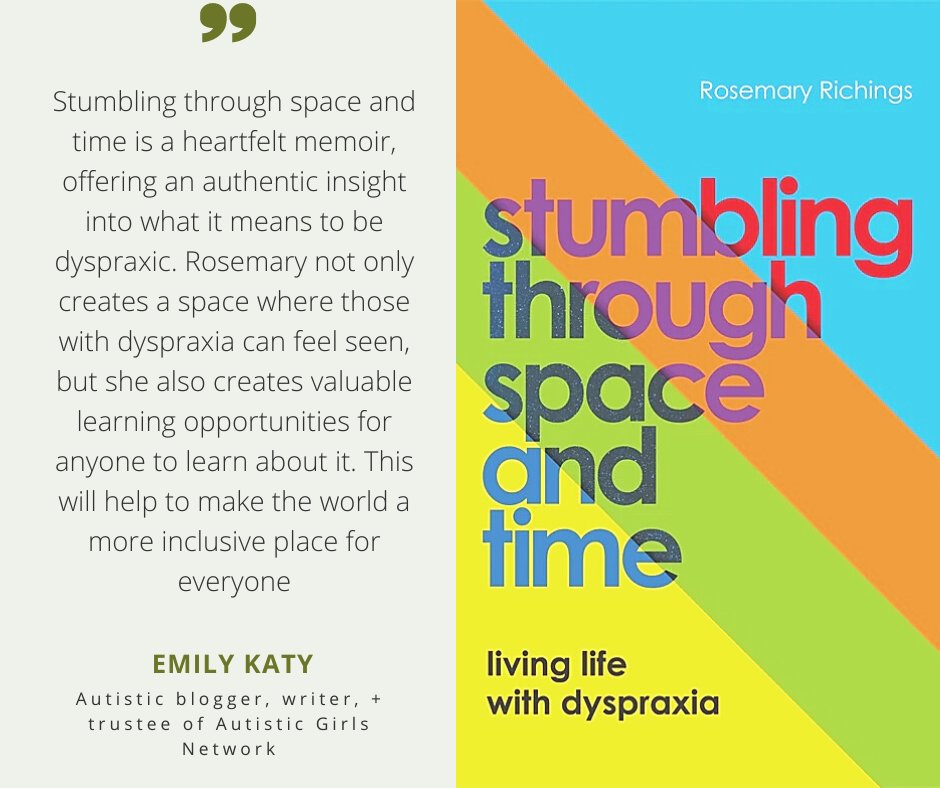
Read below the Introduction from Rosemary Richings’ upcoming book about living life with dyspraxia, Stumbling Through Space and Time. Full of practical tips and insights into the strategies that gave Rosemary the confidence to succeed, this is an essential guide for other dyspraxics and those supporting them. You too can thrive as a dyspraxic person!
In the many years that have passed since my dyspraxia diagnosis, it’s been rare for me to talk to anyone who reacts to my disability with anything besides confusion. So, let’s start with a quick definition. Dyspraxia is a disability that gives me an underdeveloped sense of space, time, and coordination. On an average day, I react to verbal instructions and the limitations of my environment at a slower rate than my peers. As a result, I can’t process verbal instructions and conversations in environments that are too noisy, busy, or filled with too many sensory distractions. Another key attribute of my disability is my lack of fine and gross motor skills. Activities like team sports, arts and crafts, and learning a new dance routine are a challenge (CanChild, 2020).
Because globally there is a lack of awareness of dyspraxia, you might think that dyspraxia is a rare neurodevelopmental disorder, but it’s more common than you might think. In fact, GMB Union called dyspraxia a “workplace issue” affecting (an estimated) 5 percent of the population (Turner & Andrew, 2020).
When did I get diagnosed? What was my life like back then?
In 1994, I received my dyspraxia diagnosis. I was unable to do all the things that children are expected to do by the time they’re in school. For me, this included everything from riding a bike and catching a ball, to reading, writing, and basic math. According to a family legend, I couldn’t even understand why an orange (as in the fruit) was orange.

I asked my father why I had medical tests pre-diagnosis. He recalled an incident when I lost control of my balance and fell down the stairs. Although, it likely had something to do with everyone’s concerns about how slowly I was learning how to get dressed, walk, and tie my shoelaces without help (Harris, Mickelson, & Zwicker, 2015). Then, once I finally learned how to write, additional challenges emerged. Holding a pen or pencil in my hands was extremely painful and no one could read my handwriting. Gripping my pen and tightly squeezing it between my middle and index fingers was the only way I could write. Otherwise, my pen would fall out of my hand mid-sentence. So, my parents did what most logical parents would do and took me to the doctor.
My parents sent me to several specialists at a major Canadian children’s hospital; I had blood tests, MRIs, appointments with physiotherapists and occupational therapists, speech pathology testing, and psychological assessments (Biotteau et al., 2019). And I hated every minute of it. Standing outside in the sunshine seemed a lot more appealing than sitting in a sterile hospital waiting room.
Several appointments later, my parents received a phone call from the family doctor, announcing my diagnosis: dyspraxia.
I don’t remember how I found out, but it was probably handled like my father telling me about a death. He waits until I’m comfortably seated; his Oxfordshire accent suddenly includes an aura of soft gentleness. Then, he explains what this means for me and everyone else we care about.
In my hometown of Toronto, 1994 was also the year of budget cuts to healthcare and education. The medical team responsible for my diagnosis had to test and diagnose me with limited resources. It was a slow process, and all my parents got was an outdated pamphlet on clumsy child syndrome.
When I received my diagnosis, my mother sat reading a book about a man who has prosopagnosia, a medical condition where you cannot recognize faces. Learning more about someone who has a neurological condition that makes him see the world differently helped her understand what having a daughter who also sees the world differently for similar reasons could be like. More recently, my dad recommended a movie called The Last Detail, where Randy Quaid’s character is neurodiverse. He told me it influenced him a great deal when he was a young man. It was his first introduction to neurodiversity.
On a global level, so many dyspraxics have stories that deserve the spotlight. But I think that you’ll be interested in my story for one very important reason: I have known that I have dyspraxia, otherwise known as developmental coordination disorder (DCD), for as long as I can remember. I never had to figure out how dyspraxia affected who I am as a person, because it has always been a background presence in my life. My peers bullied me when I was in school, which made me wish I had never received a diagnosis.
Once I struggled with other health issues, I no longer felt that way. If you haven’t developed good coping mechanisms, your chances of thriving are lower.
Good coping mechanisms take practice, and don’t happen immediately. Dyspraxics are born with their disability, but dyspraxia is the underrepresented sibling of neurodevelopmental conditions such as autism and ADHD. Autism and ADHD have been a lot more heavily studied, written about, and recognized in the medical community. Far too many dyspraxics and their families must figure out how to live with dyspraxia on their own, and growing up with dyspraxia is complicated. Everything from first dates to first jobs are awkward and acceptance is never a guarantee.

Although this isn’t an “inspiration” story, a trope in storytelling that I openly mock. Inspiration stories treat people with disabilities like a one-dimensional representation of their disability. I’m proud to say that I am so much more than a person with dyspraxia.
I’m a self-employed university graduate, wife, and proud contribution to the lives of my family. I’ve developed websites and blog posts for numerous businesses, have my own blog, and have been a trusted social media marketing resource for so many different people. In the early days of my diagnosis, I had a lot less to feel proud of, and I felt like my family’s biggest burden.
My approach to writing this book
This book attempts the difficult task of looking back on years of lived experience. However, memory is never a perfect source of information. To solve this problem, the information disclosed in this book has been verified through conversations with people who were there, several hours of research, copies of my medical records, and personal diary entries. To prevent this book from only focusing on my own experiences, I have also spoken to disabled people of diverse backgrounds, ages, and life experiences.
As an avid traveler and person who grew up in a multicultural city, I have listened to the stories of disabled people who grew up in North America, the UK, and a wide variety of European countries, along with the Middle East and India. Many of the topics explored in this book are a direct response to the conversations I have had with the people I have met so far.
Stumbling Through Space and Time will publish on the 21st September 2022, and is available for pre-order now.
Follow Rosemary Richings on Twitter @rosiemay_r.
If you liked this article, why not join our mailing list to receive exclusive content and discounts? You may unsubscribe at any time.